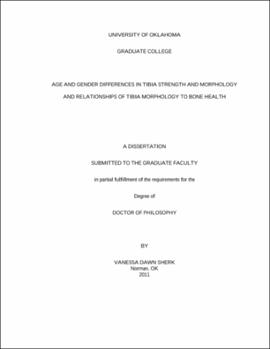| dc.description.abstract | Variability in peripheral Quantitative Computed Tomography (pQCT) measurement sites limits direct comparisons of results between studies. Further, it is unclear what estimates or surrogates of bone strength are most indicative of changes in fracture resistance due to aging, disease, or interventions. The purpose of this study was to examine the effects of age and gender on tibia morphology, and to relate indicators of tibia mass and shape to hip and spine areal bone mineral densities (aBMD) and bone mineral content (BMC) as assessed by Dual Energy X-ray Absorptiometry (DXA). Additional purposes of this study were to determine which tibia site or sites are most sensitive for detecting age, gender, or menopause-related morphology changes. Methods: Self-identifying Caucasian men (n=55) and women (n=59) ages 20-59 years had their total body, lumbar spine, and dual proximal femur aBMD and BMC measured with DXA (GE Lunar Prodigy). Body composition (total and leg bone free lean body mass (BFLBM) and fat mass (FM)) were assessed from the total body scan. Their non-dominant tibias were measured with pQCT (Stratec XCT 3000) at every 10% of the limb length from 5%-95% from distal to proximal. Volumetric BMD, BMC, and area of the total, cortical and trabecular bone were determined. Also, periosteal (PeriC) and endosteal (EndoC) circumferences, cortical thickness (CTh), bone strength index (BSI), strength strain index (SSI), moments of inertia (Imax, Imin) mass ratios, and strength to mass ratios were quantified. General health information, menstrual history, dietary intake averaged over the previous year, and lifetime bone specific physical activity (BPAQ) were assessed by questionnaires for regression analysis. Participants were grouped by decade and by gender. Results: Bone morphology and strength characteristics varied along the tibia in a nonlinear fashion. There were significant (p<0.01) site effects for all BMC, vBMD, area, strength (SSI, Imin, Imax, SSI:Tot.BMC ratio), PeriC and EndoC. Total vBMD peaked at the 35%, while cortical BMC peaked at 55% with minimums at 5% and 85%. Total BMC, SSI, SSI:Tot.BMC ratio, and Imax all peaked at the 85% site. Large gender differences (21-28%) in Tot.BMC were paralleled by differences in Tot.Area (14-25%), due to differences in Cort.BMC and area (21-25%) (p<0.01). Gender differences (p<0.01) in Imax, SSI, and SSI:Tot.BMC ratio were smallest at the 15% sites and increased through the diaphysis. Women had significantly (p<0.05) greater Cort.vBMD than men. Men had significantly (p<0.01) greater Tot.BMC ratios at 5%:35% 5%:65%, and 5%:85%. Site*gender interaction effects were significant (p<0.05) for area, BMC, circumference, and strength variables. CTh and total vBMD were lowest (p<0.05) in 50-59 yr group, and several trends (p<0.10) existed for BMC variables. EndoC was highest in the 50-59 yr group, and Imax was highest in the 40-49 yr group. Site*age interactions existed for Cort.vBMD, Tot.BMC, SSI, Imax, EndoC, and SSI:Tot.BMC. There were significant age effects for total vBMD and area, trabecular area, cortical area, SSI, Imax, and SSI:Tot.BMC. BMC ratios for 5:35% and 5:65% were highest (p<0.05) the in 20-29 yr group. Tibia total BMC and vBMD were moderately-to-strongly correlated with hip BMC and aBMD values (r = 0.31-0.76). Conclusion: Gender differences were mostly found in bone size variables, whereas age differences were mostly found in density and cortical thickness values. The magnitude of age and gender differences also varied by measurement site. Standardization of measurement sites is recommended for future reference database development and comparison.  | |
